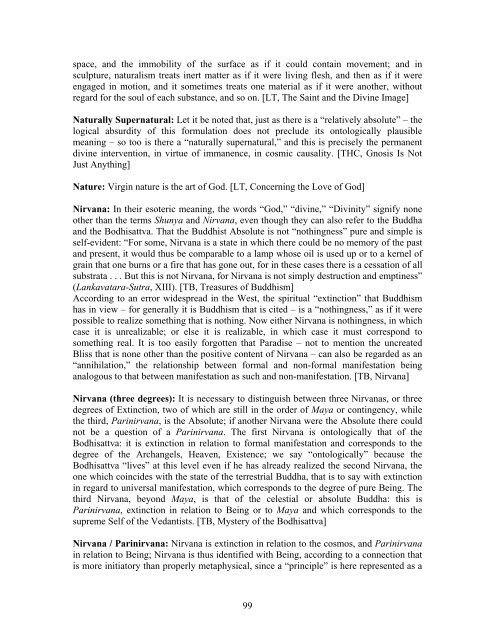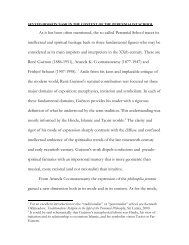glossary of terms used by frithjof schuon - Sophia Perennis
glossary of terms used by frithjof schuon - Sophia Perennis
glossary of terms used by frithjof schuon - Sophia Perennis
You also want an ePaper? Increase the reach of your titles
YUMPU automatically turns print PDFs into web optimized ePapers that Google loves.
space, and the immobility <strong>of</strong> the surface as if it could contain movement; and in<br />
sculpture, naturalism treats inert matter as if it were living flesh, and then as if it were<br />
engaged in motion, and it sometimes treats one material as if it were another, without<br />
regard for the soul <strong>of</strong> each substance, and so on. [LT, The Saint and the Divine Image]<br />
Naturally Supernatural: Let it be noted that, just as there is a “relatively absolute” – the<br />
logical absurdity <strong>of</strong> this formulation does not preclude its ontologically plausible<br />
meaning – so too is there a “naturally supernatural,” and this is precisely the permanent<br />
divine intervention, in virtue <strong>of</strong> immanence, in cosmic causality. [THC, Gnosis Is Not<br />
Just Anything]<br />
Nature: Virgin nature is the art <strong>of</strong> God. [LT, Concerning the Love <strong>of</strong> God]<br />
Nirvana: In their esoteric meaning, the words “God,” “divine,” “Divinity” signify none<br />
other than the <strong>terms</strong> Shunya and Nirvana, even though they can also refer to the Buddha<br />
and the Bodhisattva. That the Buddhist Absolute is not “nothingness” pure and simple is<br />
self-evident: “For some, Nirvana is a state in which there could be no memory <strong>of</strong> the past<br />
and present, it would thus be comparable to a lamp whose oil is <strong>used</strong> up or to a kernel <strong>of</strong><br />
grain that one burns or a fire that has gone out, for in these cases there is a cessation <strong>of</strong> all<br />
substrata . . . But this is not Nirvana, for Nirvana is not simply destruction and emptiness”<br />
(Lankavatara-Sutra, XIII). [TB, Treasures <strong>of</strong> Buddhism]<br />
According to an error widespread in the West, the spiritual “extinction” that Buddhism<br />
has in view – for generally it is Buddhism that is cited – is a “nothingness,” as if it were<br />
possible to realize something that is nothing. Now either Nirvana is nothingness, in which<br />
case it is unrealizable; or else it is realizable, in which case it must correspond to<br />
something real. It is too easily forgotten that Paradise – not to mention the uncreated<br />
Bliss that is none other than the positive content <strong>of</strong> Nirvana – can also be regarded as an<br />
“annihilation,” the relationship between formal and non-formal manifestation being<br />
analogous to that between manifestation as such and non-manifestation. [TB, Nirvana]<br />
Nirvana (three degrees): It is necessary to distinguish between three Nirvanas, or three<br />
degrees <strong>of</strong> Extinction, two <strong>of</strong> which are still in the order <strong>of</strong> Maya or contingency, while<br />
the third, Parinirvana, is the Absolute; if another Nirvana were the Absolute there could<br />
not be a question <strong>of</strong> a Parinirvana. The first Nirvana is ontologically that <strong>of</strong> the<br />
Bodhisattva: it is extinction in relation to formal manifestation and corresponds to the<br />
degree <strong>of</strong> the Archangels, Heaven, Existence; we say “ontologically” because the<br />
Bodhisattva “lives” at this level even if he has already realized the second Nirvana, the<br />
one which coincides with the state <strong>of</strong> the terrestrial Buddha, that is to say with extinction<br />
in regard to universal manifestation, which corresponds to the degree <strong>of</strong> pure Being. The<br />
third Nirvana, beyond Maya, is that <strong>of</strong> the celestial or absolute Buddha: this is<br />
Parinirvana, extinction in relation to Being or to Maya and which corresponds to the<br />
supreme Self <strong>of</strong> the Vedantists. [TB, Mystery <strong>of</strong> the Bodhisattva]<br />
Nirvana / Parinirvana: Nirvana is extinction in relation to the cosmos, and Parinirvana<br />
in relation to Being; Nirvana is thus identified with Being, according to a connection that<br />
is more initiatory than properly metaphysical, since a “principle” is here represented as a<br />
99



